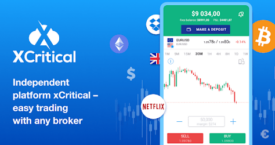What Is A Counterparty
Contents:

Let’s assume two banks enter into a vanilla (non-exotic) interest rate swap. Bank A is the floating-rate payer and Bank B is the fixed-rate payer. The swap has a notional value of $100 million and a life of five years; it is better to call the $100 million notional instead of principal because the notional is not exchanged, it is merely referenced to compute the payments. In addition, the bank or cryptocurrency exchange would need to verify the identity of their customer, if a counterparty to the transaction is using an unhosted or otherwise covered wallet and the transaction is greater than $10,000. The Fed would intermediate wholesale and retail payments, including as the direct counterparty to U.S. consumers. Because these transactions take place without a trusted or regulated intermediary, no one can rectify a bitcoin transaction with a counterparty who turns out to be fraudulent.


It’s worth noting that, as of February 2021, only 1.1% of deals on Percent have experienced some level of default in the process. When you make any investment, you’re always assuming some sort of risk. Secure the debt capital you need to scale origination volumes and reach your next stage of growth.
Defining a Counterparty
As a result, multisig support creates greater security and broader use cases for assets on Counterparty. As a result, you can recreate many financial instruments on Counterparty. Stock options, bets, escrow, futures trading, and other financial transactions are all options. The leader in news and information on cryptocurrency, digital assets and the future of money, CoinDesk is a media outlet that strives for the highest journalistic standards and abides by a strict set of editorial policies. CoinDesk is an independent operating subsidiary of Digital Currency Group, which invests in cryptocurrencies and blockchain startups. As part of their compensation, certain CoinDesk employees, including editorial employees, may receive exposure to DCG equity in the form of stock appreciation rights, which vest over a multi-year period.
MF Global, which purchased a substantial amount of emerging market debt that also collapsed in value. Storj to issue the token for their decentralized storage solution. Storj has since left Counterparty for Ethereum, and the token issued on Counterparty is deprecated. Developers and core team members have come and gone from the project over the years. Several professionals are affiliated with the project on LinkedIn, but all of them have other full-time jobs. Additionally, you can create an API integration for your smart contract to interface with your own software or other outside sources.
- Counterparty risk is a type (or sub-class) of credit risk and is the risk of default by the counterparty in many forms of derivative contracts.
- Therefore, it is recommended to use a central clearinghouse to collect margin and accelerate trade execution and settlement time to avert this risk.
- Diversifying exposure, hedging exposure, segregating high-risk contracts from lower-risk ones, and adequate capital reserves are paramount to successful risk mitigation.
- Counterparty credit risk is the risk that one party to a contract will default on its obligations.
- This is a big deal because most exchanges require a central institution to facilitate the matching of maker and taker pairs.
Market risk is another counterparty risk market participants must consider as it can negatively impact a party’s ability to deliver goods, services, or payments. The four primary market risks remain stock price fluctuations, interest rate changes, Forex volatility, and commodity price changes. Counterparty risk is a sub-category of credit risk and refers to the risk of default or inability to meet contractual obligations. Market participants should not confuse it with default risk, which applies to loans. Essentially, both counterparty risk and credit risk refer to a party’s inability to fulfill a loan’s conditions.
As a result, in order to dehttps://trading-market.org/ine whether there is counterparty risk, investors must analyze the entity that issued the bond, stock, or insurance policy. Credit default swaps, a typical derivative with counterparty risk, are frequently exchanged with another party rather than on a centralized exchange. Because the contract is directly related to the other party, there is a higher risk of counterparty default because neither side is fully aware of the other’s financial health . In this scenario, the counterparty is the exchange, not the single firm on the other side of the trade. Every buyer of an asset has to find a seller, and vice versa, in order for commerce to exist. Since the project helps create assets, exchanges, and markets for new ideas they see themselves as co-simplifying the process of finding a counterparty for your transaction.
Bull Trap: Definition and how to avoid getting into one
One useful function of digital https://forexarena.net/ is as a marker of ownership or voting rights. Imagine a scenario where you issued a digital asset to each of your company’s board members in proportion to the amount of voting power held. Or if you gave your stockholders a digital asset as a marker of the amount of stock they owned.

Bank Counterpartymeans each Bank or any Affiliate of a Bank counterparty to a Rate Management Transaction. Concurrent with entering into the Existing Forward Documents, the Common Share Portfolio of an ETF will be pledged to, and may be held by, a Bank Counterparty or affiliates thereof as security for the obligations of the ETF under the Existing Forward Documents. In March 2015, a company called EverdreamSoft released the blockchain trading card, FDCARD, on the Counterparty platform that was later usable in their blockchain game Spells Of Genesis.
What type of risk is counterparty risk?
When one https://forexaggregator.com/ to a contract fails to meet its obligations, the other party can claim the collateral. This gives the other party a source of funds to cover its losses. Collateral can be in the form of cash, securities, or other assets. This collateral can be in the form of cash, securities, or other assets. Counterparty credit risk is a major concern for businesses that engage in financial contracts with other companies.

In essence, the crypto economy is not immune to the problems inherent in the trust-based transactional model Satoshi warned us about 14 years ago. For what it’s worth, the trust-based model remains central to the success of cryptocurrency and, judging by the events of the past few weeks, also its potential downfall. Having centralized entities control a significant share of the crypto market ultimately exposes crypto users to counterparty risks. Apart from crypto exchanges, the other services that are susceptible to counterparty risks include crypto lending platforms, custodial wallet providers, crypto card services and centralized stablecoins. Dealing with a trusted and financially stable party is the most efficient counterparty risk management tool.
Every financial transaction requires a buyer and a seller, which become the counterparty to each other. In centralized markets, like equity markets, a clearinghouse collects and ensures each party receives its items. In decentralized over-the-counter markets, like Forex, brokers and liquidity providers take over that role. Usually, the process remains smooth and efficient, but what happens when one party fails to deliver?
Comparison Between Counterparty Risk and Credit Risk
Nevertheless, it doesn’t seem likely to overthrow Ethereum anytime soon, nor does it try to. Satoshi Nakamoto, in the Bitcoin whitepaper published 14 years ago, explained that eliminating intermediaries was the ideal solution to the weaknesses of trust-based payment models. To achieve this, Satoshi introduced a peer-to-peer network anchored by trustless cryptographic proof that entails users to transact directly without requiring third parties. Notably, this model eliminates the need for centralized entities.
Counterparty risk exposure is the level of risk facing the company from any one of the counterparties. This type of risk can happen across many spheres, including finance, insurance, etc. Trade exposures include the current and potential future exposure of a clearing member or a client to a CCP arising from over-the-counter derivatives, exchange traded derivatives transactions or securities financing transactions, as well as initial margin.
Understanding What Is a Forex Broker and When You Need It the Most – Qrius
Understanding What Is a Forex Broker and When You Need It the Most.
Posted: Tue, 28 Feb 2023 17:09:13 GMT [source]
They often take the services of online or traditional brokerage firms or advisors for investment decision-making. Financial AssetsFinancial assets are investment assets whose value derives from a contractual claim on what they represent. These are liquid assets because the economic resources or ownership can be converted into a valuable asset such as cash.
What is a Counterparty Risk? Explained with a Counterparty Risk Example
A thorough evaluation of potential counterparties based on a variety of variables, such as credit rating, credit spread, and experience trading a certain instrument , is typically necessary. Furthermore, the readiness to adopt counterparty risk-mitigation steps outlined in legal documentation can be essential in picking your counterparty. Counterparty risk exists in financial investment products such as stocks, options, bonds, and derivatives. Bonds are graded from AAA to junk bond status by rating organizations such as Moody’s and Standard and Poor’s to determine the level of counterparty risk.
Dealing with a counterparty who is facing insolvency – Lewis Silkin
Dealing with a counterparty who is facing insolvency.
Posted: Fri, 03 Feb 2023 17:22:59 GMT [source]
Collection scoring — this process helps to understand another business’s debt and manage it if need be. Terms and limits – monitor exposure risk and ensure limits are in place where they need to be. Our diverse set of investment offerings target annualized returns of up to 20%.
Similarly, if you enter into a home insurance contract, the insurer is the counterparty. A counterparty can be an individual or some other entity, such as a company or a government. A counterparty is a legal entity, unincorporated entity, or collection of entities to which an exposure of financial risk may exist. The word became widely used in the 1980s, particularly at the time of the Basel I deliberations in 1988.
Risk-neutral distributionis a distribution of market values or exposures at a future time period where the distribution is calculated using market implied values such as implied volatilities. Distribution of exposuresis the forecast of the probability distribution of market values that is generated by setting forecast instances of negative net market values equal to zero . A clientis a party to a transaction with a CCP through either a clearing member acting as a financial intermediary, or a clearing member guaranteeing the performance of the client to the CCP. For the purposes of the CCR standard, where a CCP has a link to a second CCP, that second CCP is to be treated as a clearing member of the first CCP. Whether the second CCP’s collateral contribution to the first CCP is treated as initial margin or a default fund contribution will depend upon the legal arrangement between the CCPs.
- They are examples of credit contagion from counterparty risk, and the most trusted institutions created conditions leading to sharp market sell-offs.
- In August 2014, Dogeparty, which is based on Dogecoin, was forked off Counterparty, offering lower fees and faster transaction times.
- Thus, the VaR can at least provide a hypothetical measure of the risk of counterparty default on a credit default swap.
- Finally, it is important to note that CCPs are usually business entities, part of a larger group, expected to be profitable, and generate sufficient cash to meet financial obligations in addition to their core function of reducing counterparty credit risk.
- A derivative is a securitized contract whose value is dependent upon one or more underlying assets.
Whatever the reasons may be, the common denominator is that users are at risk of losing their funds permanently. If this proves to be the case, the affected exchange or service provider has defaulted in its contractual obligation to process withdrawals when due. Since exchanges are the major gateways to the crypto market, new and experienced crypto participants often deposit their funds with them. Users trust that these exchanges will have plenty of coins available whenever any user initiates a withdrawal. Unfortunately, as FTX’s collapse has shown, this trust has cost many people their crypto wealth if the exchange misappropriates customer funds and cannot cover withdrawals.
Leave a Reply